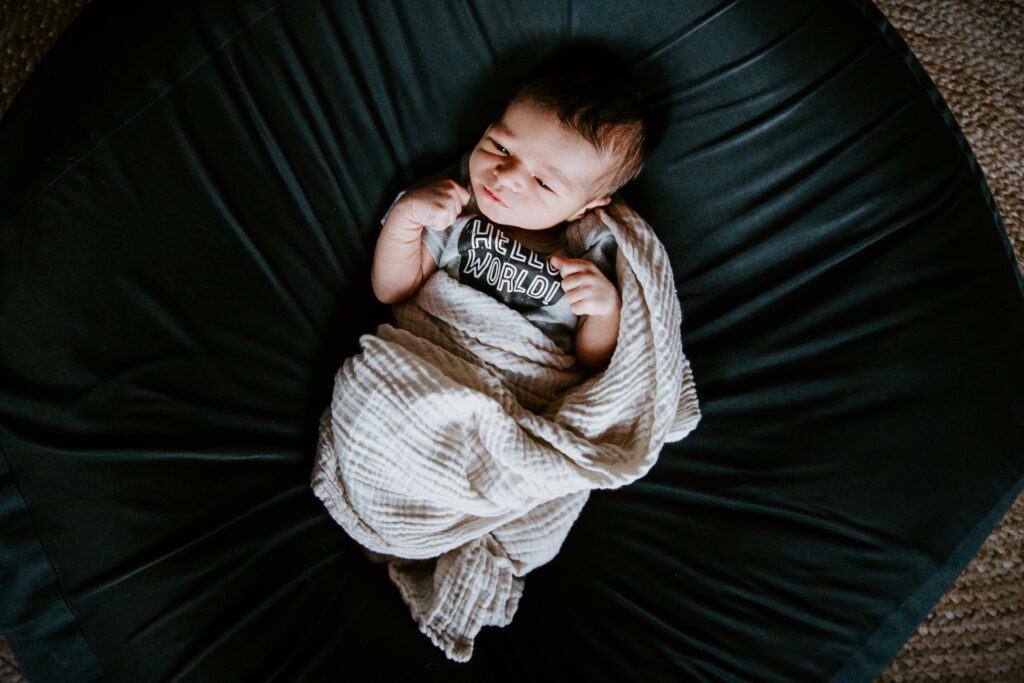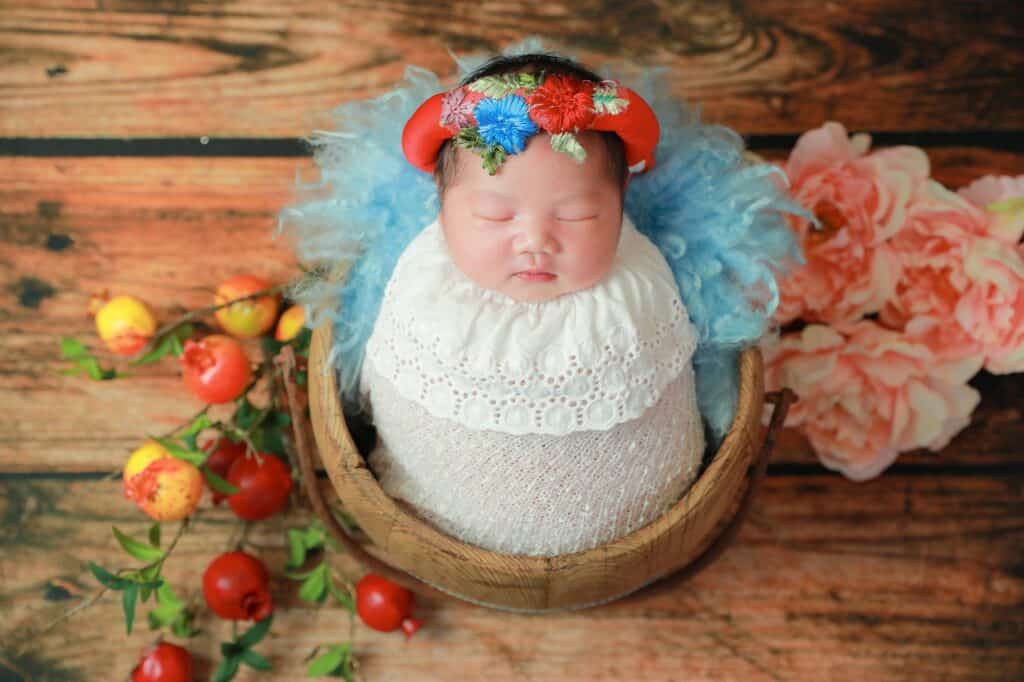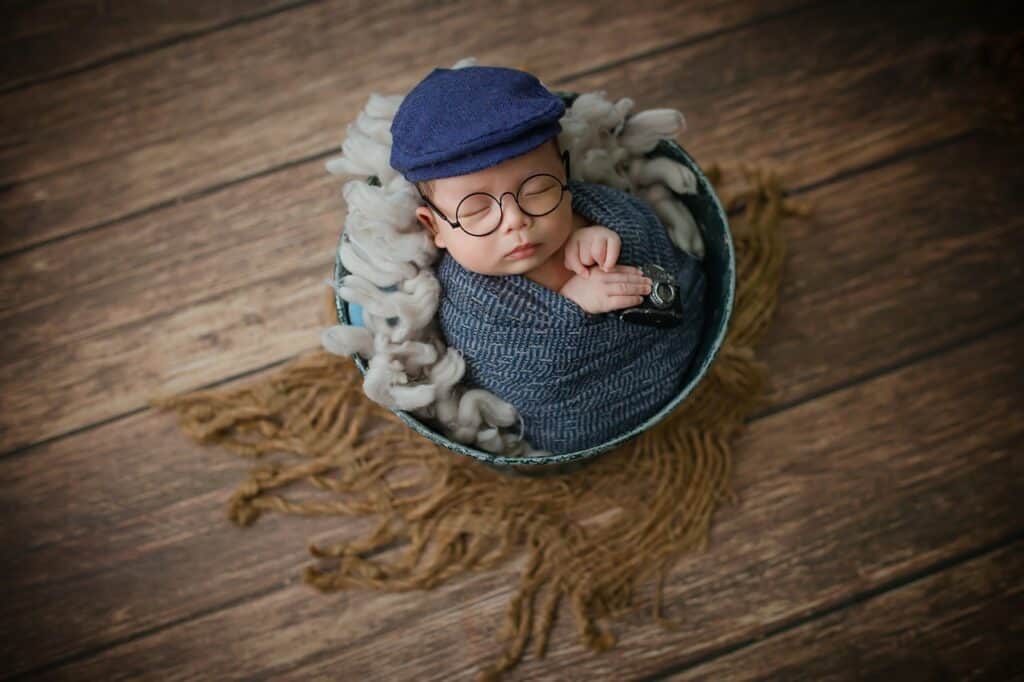Swaddling is a popular technique used by parents to help soothe their newborns and promote better sleep. However, new parents may wonder how many swaddles they need to purchase to ensure they have enough for their baby. The answer to this question depends on various factors, including how often the baby needs to be swaddled and the type of swaddle being used.
Understanding Swaddles Swaddles are blankets or wraps that are used to tightly swaddle a baby, mimicking the sensation of being in the womb. They can help prevent startle reflexes and promote better sleep, making them a popular choice for parents of newborns. There are different types of swaddles available, including traditional blankets, swaddle sacks, and zip-up swaddles.
Key Takeaways
- The number of swaddles needed depends on how often the baby needs to be swaddled and the type of swaddle being used.
- Swaddles can help prevent startle reflexes and promote better sleep in newborns.
- There are different types of swaddles available, including traditional blankets, swaddle sacks, and zip-up swaddles.
Understanding Swaddles
Swaddling is a practice that has been used for centuries to keep newborn babies comfortable, calm, and secure. Swaddling involves wrapping a baby snugly in a blanket or swaddle sack to mimic the feeling of being in the womb. This can help to soothe babies and reduce the likelihood of the Moro reflex, which can cause them to startle and wake up.
When it comes to swaddles, there are many options available, including traditional swaddles, swaddle blankets, receiving blankets, and more. Some swaddles use velcro or zippers to make it easier to wrap babies up securely, while others are designed to allow babies to have their arms up, which can be more comfortable for some babies.
So, how many swaddles do you need? The answer depends on your baby and your routine. Some parents prefer to have several swaddles on hand so that they can rotate them throughout the day, while others find that one or two swaddles are sufficient. It’s important to make sure that any swaddles you use are safe and comfortable for your baby.
Overall, swaddling can be a helpful tool for parents of newborns, but it’s important to make sure that you’re doing it safely and that your baby is comfortable and secure. If you’re unsure about how to swaddle your baby or which swaddle to use, talk to your pediatrician or a baby expert for advice.
Types of Swaddles
When it comes to swaddles, there are various types available in the market. Each type has its own unique features and benefits. Some of the most common types of swaddles are:

1. Muslin Swaddle Blankets
Muslin swaddle blankets are made from a lightweight, breathable fabric that is perfect for swaddling babies. They are soft, gentle, and durable, making them a popular choice among parents. Muslin swaddle blankets are available in different sizes and designs, and they can be used for various purposes, such as burping, nursing, and as a stroller cover.
2. Cotton Swaddles
Cotton swaddles are made from a soft, natural fabric that is gentle on a baby’s delicate skin. They are easy to wash and maintain, and they come in various sizes and designs. Cotton swaddles are perfect for newborns and infants, as they provide a warm, cozy environment that helps them sleep better.
3. Velcro Swaddles
Velcro swaddles are designed to make swaddling easier and more convenient. They come with adjustable tabs that allow parents to adjust the swaddle to fit their baby’s size and shape. Velcro swaddles are available in different sizes and designs, and they are perfect for parents who are new to swaddling.
4. Receiving Blankets
Receiving blankets are multi-purpose blankets that can be used for swaddling, burping, nursing, and as a stroller cover. They are made from a soft, breathable fabric that is gentle on a baby’s skin. Receiving blankets come in different sizes and designs, and they are perfect for parents who are looking for a versatile and practical swaddle option.
5. Bamboo Swaddles
Bamboo swaddles are made from a soft, natural fabric that is hypoallergenic and antibacterial. They are perfect for babies with sensitive skin, as they are gentle and non-irritating. Bamboo swaddles are available in different sizes and designs, and they are perfect for parents who are looking for a sustainable and eco-friendly swaddle option.
6. Aden + Anais Swaddles
Aden + Anais swaddles are made from a lightweight, breathable fabric that is perfect for swaddling babies. They are soft, gentle, and durable, making them a popular choice among parents. Aden + Anais swaddles are available in different sizes and designs, and they can be used for various purposes, such as burping, nursing, and as a stroller cover.
7. Mebie Baby Swaddles
Mebie Baby swaddles are made from a soft, breathable fabric that is perfect for swaddling babies. They are available in different sizes and designs, and they are perfect for parents who are looking for a stylish and practical swaddle option. Mebie Baby swaddles are easy to wash and maintain, and they provide a warm, cozy environment that helps babies sleep better.
8. Love to Dream Swaddle Up
Love to Dream Swaddle Up is a unique swaddle that allows babies to sleep in a natural position with their arms up. It is made from a soft, breathable fabric that is gentle on a baby’s skin. Love to Dream Swaddle Up is available in different sizes and designs, and it is perfect for parents who are looking for a swaddle that promotes natural sleep patterns.
Why Swaddle a Baby
Swaddling a baby involves wrapping them snugly in a blanket or cloth. It has been a common practice for centuries, and for a good reason. Swaddling offers several benefits to the baby and the parent.

1. Comfort
Babies are used to the confined space of the womb, and swaddling can provide a similar feeling of security. It can help soothe them when they are feeling fussy or agitated. Swaddling can also help prevent babies from scratching their face or pulling their hair.
Also read: When Can You Cut Baby’s Hair
2. Startle Reflex and Moro Reflex
Babies have a startle reflex, which can cause them to wake up suddenly and cry. Swaddling can help reduce the intensity of the startle reflex, making it easier for the baby to fall asleep and stay asleep. Swaddling can also help prevent the Moro reflex, which is an involuntary startle reflex that can cause the baby to feel like they are falling.
3. Calm and Secure
Swaddling can help calm and soothe a baby, making them feel more secure. It can also help reduce the risk of Sudden Infant Death Syndrome (SIDS) by preventing the baby from rolling onto their stomach while sleeping.
4. Fall Asleep and Sleep Time
Swaddling can help babies fall asleep faster and stay asleep longer. It can also help establish a bedtime routine, which is essential for developing healthy sleep habits.
In conclusion, swaddling is a safe and effective way to help calm and soothe a baby, reduce the risk of SIDS, and establish healthy sleep habits. It is important to note that not all babies enjoy being swaddled, and it is essential to follow safe swaddling practices to prevent injuries.
How Many Swaddles Do You Need
Swaddling is an age-old technique that can help soothe and calm newborns. But how many swaddles does one need? The answer depends on a few factors, including laundry frequency, baby’s age, and personal preference.

For newborns, it’s recommended to have at least 2-3 swaddles on hand, as they tend to go through multiple outfit changes in a day. As babies get older and become less reliant on swaddling, parents may find they need fewer swaddles.
For minimalist parents, one or two swaddles may suffice, especially if they plan on doing laundry frequently. On the other hand, parents who prefer to have a larger baby gear collection may opt for a pack of 4-6 swaddles.
When it comes to adding swaddles to a baby registry, it’s best to include a variety of sizes and styles. This allows parents to experiment and find the best swaddles for their baby’s needs.
It’s also important to consider the frequency of laundry day. If parents plan on doing laundry every day or every other day, they may need fewer swaddles than those who only do laundry once a week.
Some frequently asked questions about swaddling include whether newborns need to be swaddled all day. The answer is no, as newborns should have some time to move their limbs and develop their motor skills. Swaddling is typically used for sleep and naps.
In terms of wardrobe, swaddles can be used as a replacement for traditional outfits during the first few weeks of life. This can help simplify the wardrobe and make dressing baby easier.
Overall, the number of swaddles one needs depends on personal preference and lifestyle. Having a few on hand is always a good idea, but the exact number may vary from family to family.
Safety Considerations for Swaddling
Swaddling can be a helpful way to calm a newborn and help them sleep better. However, it is important to consider safety when swaddling your baby. Here are some safety considerations to keep in mind:
- Safe Swaddling Techniques: Always use safe swaddling techniques to ensure that the baby’s arms and legs are snugly wrapped but not too tight. Avoid covering the baby’s face or head with the swaddle, and make sure the baby’s hips are in a safe position.
- SIDS Risk: While swaddling can help calm a baby and promote sleep, it is important to note that swaddling may increase the risk of Sudden Infant Death Syndrome (SIDS), especially if the baby is swaddled too tightly or placed on their stomach to sleep.
- Rolling Over: Once a baby begins to roll over, it is important to stop swaddling them as it can increase the risk of suffocation.
- Breathable Fabric: Always use a breathable fabric when swaddling your baby. Avoid using thick blankets or materials that could cause the baby to overheat.
- Positioning: Always place your baby on their back to sleep, and avoid placing them on their side or stomach while swaddled.
- Suffocation Risk: Never place loose blankets or toys in the crib while the baby is swaddled, as this can increase the risk of suffocation.
- AAP Recommendations: The American Academy of Pediatrics (AAP) recommends that parents stop swaddling their baby once they show signs of rolling over, usually around 2-3 months of age.
- Hip Dysplasia: It is important to ensure that the swaddle does not restrict the baby’s hip movement, as this can increase the risk of hip dysplasia. Always use a swaddle that allows the baby’s hips to move freely.
By following these safety considerations, parents can help ensure that their baby is safe and comfortable while swaddled.
Transitioning Out of Swaddling
As babies grow and develop, they eventually reach a point where they need to transition out of swaddling. This can be a tricky process for both parents and babies, as it often involves finding a new way to help babies feel secure and comfortable while they sleep.

One common sign that it’s time to transition out of swaddling is when babies start to roll over. Once babies can roll from their back to their stomach and vice versa, it’s no longer safe to have them swaddled. This is because swaddling restricts their movement and can make it difficult for them to move their arms and legs if they end up on their stomach.
When transitioning out of swaddling, there are a few options parents can consider. One popular choice is the Halo Sleepsack Swaddle, which has a two-way zipper and can be used with arms in or out. This allows parents to gradually transition their baby out of swaddling by leaving one arm out at a time.
Another option is the Love to Dream Swaddle Up, which has a unique design that allows babies to sleep with their arms up. This can help them feel more secure and comfortable as they adjust to sleeping without being swaddled.
Regardless of which option parents choose, it’s important to make sure that the new sleepwear is safe and secure. Look for features like hook and loop patches or Velcro straps to ensure that the sleepwear stays in place throughout the night.
Overall, transitioning out of swaddling can be a challenging process, but with the right tools and techniques, parents can help their babies sleep comfortably and safely.
Additional Uses of Swaddles
Swaddles are often seen as a baby essential for sleep and keeping babies cozy and secure. However, swaddles can also serve a variety of other purposes beyond just sleep. Here are some additional uses of swaddles:
1. Spit-up and Burp Cloth
Swaddles can be used to clean up spit-up and as a burp cloth. Simply drape the swaddle over your shoulder or lay it on your lap while burping your baby. The soft and absorbent fabric of the swaddle can help catch any spit-up and prevent it from getting on your clothes.
2. Stroller Cover
On a sunny day, swaddles can be used as a cover for your baby’s stroller to protect them from the sun. The lightweight and breathable fabric of the swaddle can help keep your baby cool and comfortable while still providing shade.
3. Blowouts
Swaddles can also come in handy for diaper blowouts. If your baby has a blowout while out and about, use the swaddle as a makeshift changing pad to protect surfaces from getting soiled.
4. Bib
In a pinch, swaddles can be used as a bib. Simply fold the swaddle into a triangle and tie it around your baby’s neck. The soft fabric of the swaddle can help catch any drool or food that may spill out during feeding.
5. Breastfeeding Cover
Swaddles can also be used as a breastfeeding cover. Simply drape the swaddle over your shoulder and your baby while nursing to provide privacy and comfort.
6. Too Hot or Too Cold
Swaddles can help regulate your baby’s temperature. Use a swaddle to keep your baby warm on chilly nights or as a lightweight blanket on warmer days.
7. Scratch Protection
If your baby has a tendency to scratch themselves, swaddles can be used as scratch mittens. Simply wrap the swaddle around your baby’s hands to prevent them from scratching their face or body.
Overall, swaddles are a versatile baby essential that can serve many purposes beyond just sleep. With their soft and breathable fabric, they can be used for everything from cleaning up spit-up to protecting your baby from the sun.
Choosing the Right Swaddle
Swaddling is an age-old technique that has been used to soothe babies and promote better sleep. However, with so many swaddles available in the market, choosing the right one can be overwhelming for new parents. Here are some factors to consider when selecting the perfect swaddle for your baby.

1. Size and Comfort
Swaddles come in different sizes to fit babies of different ages and weights. It is important to choose the right size to ensure that the swaddle is snug but not too tight. A swaddle that is too small can be uncomfortable for the baby, while one that is too big can be ineffective in keeping the baby snug.
When it comes to comfort, look for swaddles made from soft and breathable materials. Muslin, cotton, and bamboo are popular options that are gentle on the baby’s skin and help regulate body temperature.
2. Velcro, Zippers, and Snaps
Swaddles come with different types of closures, including velcro, zippers, and snaps. Velcro closures are easy to use and adjust, while zippers and snaps provide a more secure fit. Consider which closure type works best for you and your baby’s needs.
3. Warmth and Climate
The warmth and climate of your baby’s sleeping environment should also be considered when choosing a swaddle. For colder climates, look for swaddles that provide extra warmth, such as those made with fleece or wool. In warmer climates, opt for lightweight and breathable swaddles to prevent overheating.
4. Personal Preference and Convenience
Ultimately, the best swaddle is one that works for you and your baby’s needs. Some parents prefer swaddles with specific designs or patterns, while others prioritize convenience and ease of use. Consider what features are important to you and your lifestyle when selecting a swaddle.
Related: 3 Month Old Still Wearing Mittens
Frequently Asked Questions
How many swaddles do I need?
It is recommended to have at least 2-3 swaddles on hand to ensure that you always have a clean one available.
What are the best swaddles for colic?
Swaddles with a snug fit and those made with materials that provide extra comfort, such as Dreamland Baby’s weighted swaddles, are recommended for babies with colic.
What is the recommended number of swaddles for a newborn?
It is recommended to have at least 2-3 swaddles for a newborn. This is because newborns tend to spit up or have diaper leaks, which may require a change of swaddle. Additionally, having multiple swaddles can help with laundry rotation.
How many swaddles should I have for the first year?
For the first year, it is recommended to have 5-7 swaddles. As babies grow, they may need larger swaddles or transition to sleep sacks. Having a few extra swaddles on hand can also be helpful in case of accidents or spills.
What is the difference between a swaddle and a sleep sack?
A swaddle is a blanket that is wrapped around a baby to help them feel secure and prevent the startle reflex. A sleep sack is a wearable blanket that allows a baby to move their arms and legs while still feeling secure. Swaddles are typically used for newborns, while sleep sacks are used for older babies who are ready to transition out of swaddling.
How long should a baby be swaddled?
Babies can be swaddled for up to 3-4 months, or until they start showing signs of rolling over. Once a baby can roll over, they should no longer be swaddled as it can be a safety hazard.
What are the best types of swaddles for newborns?
The best types of swaddles for newborns are those that are made of breathable, lightweight materials such as cotton or muslin. Swaddles with Velcro or snaps can also be helpful for parents who are new to swaddling and want a secure fit.
How many swaddles do I need to bring to the hospital?
It is recommended to bring at least one or two swaddles to the hospital for the newborn. However, it is always a good idea to check with the hospital beforehand to see if they provide swaddles or have any specific requirements.

Iesha is a loving mother of 2 beautiful children. She’s an active parent who enjoys indoor and outdoor adventures with her family. Her mission is to share practical and realistic parenting advice to help the parenting community becoming stronger.
